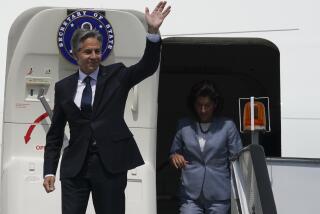It’s Superpromising
- Share via
More than 1,200 scientists, engineers, business people and venture capitalists gathered in Washington last week for an extraordinary two-day meeting aimed at speeding the movement of new superconducting materials from the laboratory to the marketplace. The centerpiece of the confabulation was an address by President Reagan, who echoed many speakers in asserting that the recent breakthroughs in superconductivity “bring us to the threshold of a new age” and announced an 11-point program to help bring it about.
A word of caution. The developments in superconductivity in the last 10 months have been nothing short of extraordinary. A year ago few nonscientists had even heard the word; now, while it is not quite as well known as, say, Vanna White, many people are aware that superconductivity is the phenomenon by which a material loses all resistance to the transmission of electricity. As a result, an electric current can pass through such material without any loss whatsoever--a state of affairs that visionaries predict will revolutionize the world as much as the electric light bulb did a century ago.
But--there is always a but--it’s not quite that simple. Superconductivity occurs only at very low temperatures. Until October of last year the critical temperature was close to absolute zero (minus 459 degrees Fahrenheit), which limited its utility. Then a breathtaking series of discoveries was made by scientists around the world of a new class of ceramic materials that are superconducting at higher and more practical temperatures--perhaps as high as the temperature of dry ice. There is hope--repeat, hope--that superconductivity can be achieved at room temperature--a development that would affect every piece of electrical equipment now in use. Major practical applications include medicine, transportation, computers and the transmission of electricity. “The effects of these discoveries will change the world in ways that we will all have to stretch our imaginations to conceive,” Dr. William R. Graham, the White House science adviser, told the meeting.
But so far these wonderful materials exist only in the laboratory. They are very brittle, and no one has a good idea about how to bend them or how to make them into wire. Nor have the materials been able to carry large amounts of current. Nor, except for educated guesses, can scientists explain how this new phenomenon works.
The promise of superconductivity is so great that the federal government has put all its weight behind helping science and industry make it a reality. That was the significance of Reagan’s appearance at the superconductivity meeting and the announcement of his 11-point “Superconductivity Initiative.” Among other things, the President is asking Congress to relax the antitrust laws to allow companies to work together on superconductivity (a good idea); he is also asking for a stiffening of the patent laws to make it harder for foreign companies to infringe on U.S. developments (another good idea), and he is asking for an exception to be made in the Freedom of Information Act so that the government’s national laboratories can assist in the proprietary work of private companies. This is not a good idea. The work of the national laboratories, which is paid for by the taxpayers, should be available to everyone.
Nor was it a good idea to bar foreigners from the Washington meeting. The President’s desire to advance American business is understandable and commendable, but knowledge knows no national bounds. It advances best in the open. The Administration is correct in seeking to realize the enormous promise of superconductivity. But it is a benefit not just for this country but for the world.





